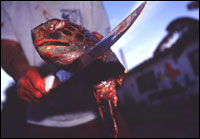To be an endangered sea turtle near Punta Abreojos on Mexico’s Baja Peninsula is to be a lucky animal. In this remote fishing village, the local fishing cooperative cracks down on any member caught with a turtle. For the first offense, you lose fishing privileges for three months, and must instead don a hairnet and mask and work in the seafood processing plant. The second offense gets you kicked out of the coop, which has sole rights to the lucrative local lobster and abalone fishery.
To be an endangered sea turtle 220 miles to the south in Magdalena Bay is to be less fortunate. In the coastal town of San Carlos, many local residents still regularly eat sea turtle, even though it has been illegal to catch or eat them in Mexico since 1990. Of the seven fishing coops in town, three are starting to work on protecting turtles — but any turtle they save, a member of another coop might catch. People come from all over Mexico to fish the rich waters of Magdalena Bay, which has been called Baja’s Chesapeake. Outsiders poach many things, among them turtles.
The problem for any turtle in Baja is this: Protection is the exception rather than the rule.
Five species of sea turtle, all endangered, come to the rich waters off the Baja Peninsula, which stretches like an 1,000-mile-long finger south of the state of California. On one side lies the Pacific Ocean, on the other, the Gulf of California. Here in Baja, turtles end up on barbecues and in soup. Weddings, holidays, family get-togethers, even political rallies call for turtle. The blood and oil of cahuama is believed to bring health. Turtle meat won’t appear on restaurant menus — but customers in the know can discreetly ask for it.
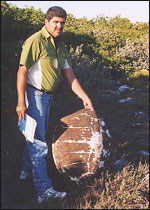
Ysidro Arce with the shell
of an eaten turtle.
Photo: Deborah Knight.
Ysidro Arce, a fisher in Punta Abreojos and a member of the coop that strictly enforces the ban on catching turtles, says, “Eating sea turtle is an old, bad custom. When we see a big turtle, we only think about eating it, like beef. We don’t think about liberation.”
Arce is a burly man, with thick black eyebrows and dark eyes that sparkle when he smiles. He is part of a group of Punta Abreojos fishers who have developed a different kind of passion for turtles: protecting them. One day each month, the group sets nets at a monitoring site and weighs, measures, and tags the turtles caught. They bring along children, who pat the turtles, name them, and help set them loose. In the local school, the principal and teachers have taken up the cause, and children now lecture their fathers: If you catch turtles, they will not be around when I grow up. Thanks to the efforts of Arce and his colleagues, few people eat turtle any more in this village of 800.
A Shell of a Problem
The Punta Abreojos group is one of six monitoring teams that, for the last year, have set nets for a monthly turtle survey at different sites around the peninsula. Together, the groups are part of the Grupo Tortuguero de Las Californias (the Sea Turtle Conservation Network of the Californias), which was founded by Wallace J. Nichols, a U.S. sea turtle researcher. Nichols came to Baja in 1991 to study the genetics and migration patterns of sea turtles. Over time, he noticed that large numbers of turtles were being eaten, including a substantial number of his study animals.
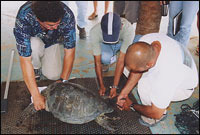
Sea Turtle Conservation Network members
tag a turtle.
Photo: Deborah Knight.
Nichols set himself a goal: On every trip he would ask 100 people how often they ate turtle. Many said their families ate between four and 10 turtles per year. He also went to village dumps and counted carapaces by the hundreds. Finally, he commissioned a formal survey. The estimate of the number of turtles eaten annually on the Baja Peninsula alone: 30,000. At that rate, Nichols says, whatever interesting facts he might learn by studying the turtles wasn’t going to matter.
Nichols now carries his message about ending sea-turtle consumption to Baja’s small towns and remote fishing camps. There he recruits converts to this work from among the people who know turtles best: local fishers.
The idea for the Sea Turtle Conservation Network came to Nichols through the relationships he developed with fishers who helped him with his research. “I was talking to all these guys and telling them stories about the other guys. And I thought, they’d like each other, and they’d feed off each other and encourage each other. It’s not really enough for this gringo biologist to roll in every once in a while and tell stories.” After drumming up $1,300 in grant money, Nichols organized the network’s first meeting. “I called and faxed and drove and saw everybody and said, ‘Here’s the date, here’s the place, I’m going to rent a block of hotel rooms, pay for your gas, I hope you can be there.’ Fifty people came. We set the ground rules: Okay, everybody has a vote, everybody has a voice, this is a round table, open discussion, we have an agenda, a heavy emphasis on talking to each other and continuing conversations outside of the meeting. For a lot of the guys, it was the first time they’d ever been invited to a meeting outside of their fishing coops.”
From Sea to Shining Sea Turtle
That first meeting of the Sea Turtle Conservation Network was held in 1999. Recently, in the village of San Carlos, the teams held a two-day gathering to report on the results of their first year of monitoring and to talk about problems: fishers who catch turtles while fishing for other sea creatures, active turtle poachers, and the lack of government enforcement against poaching in general.
Nichols opened the meeting by welcoming the participants and projecting onto the wall a map of Baja and the entire Pacific Ocean. “Baja has a global importance for sea turtles,” he told the team members. He pointed to Japan, where loggerhead turtles hatch before crossing the Pacific to feed on the pelagic crabs that turn the waters off Baja red. The turtles return to Japan to nest on the same beach where they hatched — but in the past 12 years, the number of returning turtles has declined by half.
Nichols then pointed to Michoacan on the Mexican mainland, site of the nesting beaches for East Pacific green turtles, the kind most commonly eaten in Baja. The juveniles come to Baja’s coastal waters to browse on sea grass and algae. They take up to 30 years to reach sexual maturity, and may eventually reach 300-400 pounds; they then return every other year to Michoacan to reproduce. For the last two decades, researchers have protected the nesting beaches from poachers, who used to dig up most of the eggs to sell them in the cities. Nevertheless, the number of returning turtles has continued to fall, from 25,000 in 1970 to fewer than 500 in 1990. The number finally increased in the last two years, but Nichols believes there is a good reason it has not rebounded faster: Too many turtles are eaten, many before they have reproduced even once.
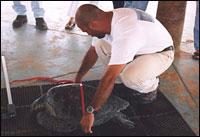
How does your turtle grow?
Photo: Deborah Knight.
Among the meeting’s attendees was Miguel Lizarraga, a fisher from San Carlos, the town in Magdalena Bay where life is tough on turtles. Lizarraga stopped eating turtle two years ago when he signed the Sea Turtle Conservation Network pledge. He has become an ardent supporter of the cause, but acknowledges that at times the magnitude of the challenge can be overwhelming. Of the 400 members in his own coop, he estimates that 250 still eat turtle. After he took an agent from PROFEPA, one of two government entities in charge of protecting turtles, out on an enforcement run using his own boat and gas, the head of another coop threatened and punched Lizarraga. Like many members in the Sea Turtle Conservation Network, he fears physical retaliation if he were to report known turtle poachers in his area — especially since some of the poachers associate with drug smugglers in coastal waters, supplying them with food and fuel.
“The government needs to help us,” Lizarraga says.
Twice, Lizarraga has made the long trip to the city of La Paz, where the nearest PROFEPA office is located, only to be told that if he didn’t have proof of illegal activity, nothing could be done. Even those agents who do try to enforce the law face a tough task: There are just 13 agents assigned to the entire southern half of the peninsula — about a thousand miles of sparsely populated coastline. When soldiers drove past during the conference, heading out to the point where fishing boats land, Lizarraga commented bitterly, “Probably they will be given money and not see anything.”
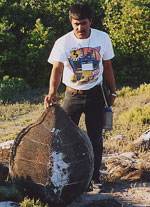
Fisher Ranulfo Mayoral with the
shell of an eaten turtle.
Photo: Deborah Knight.
Some members of the Sea Turtle Conservation Network hope that one of the benefits of protecting turtles will be that tourists will someday pay to see them. That is the dream of fisher Ranulfo Mayoral, who makes money in the winter by taking tourists out to see the gray whales that come to remote San Ignacio Lagoon. Mayoral’s face lights up as he describes his childhood, when the lagoon was filled with so many large turtles that fishers who brought their catch to the shore would throw the smaller ones back. He and his friends would grab hold of the turtles and see whose could swim the fastest. Now, many of the turtles caught are small and have never reproduced.
One such turtle had been caught and brought to the meeting in San Carlos. Its large black eyes viewed the onlookers with a 50-million-year-old aura of distrust. Experienced team members demonstrated how to measure the turtle and snap identification tags onto its hind flippers. It was not yet of reproductive age, so they could not determine its sex, but they named it Maria anyway; most fishers name the turtles they tag after their daughters or girlfriends. One man hefted her into a net to be weighed, struggling to manage her — all 53 pounds, as it turned out — while her powerful front flippers flailed the air. Later, they took Maria out in a boat and lowered her into the water. With two mighty strokes, she vanished.

Miguel Lizarraga with Maria.
Photo: Deborah Knight.
Will Maria make it? Perhaps. Nichols believes that a tipping point may have been reached. As he drove out of town before dawn the morning after the meeting, he encountered something he had never seen before: Soldiers and fisheries inspectors at a roadblock, stopping traffic to ask, “Any shrimp? Any turtles?”
A few weeks later, a high level PROFEPA official from Mexico City met with representatives from the U.S. Fish and Wildlife Service, the U.S. National Marine Fisheries Service, and the Sea Turtle Conservation Network. The PROFEPA official made a commitment to actively investigate turtle poachers and acknowledged that some turtle meat even makes it across the border into southwestern U.S. cities.
Meanwhile, Nichols sees the get-tough attitude of the Punta Abreojos fishers spreading through all six of the turtle monitoring teams. These local people, Nichols says, have a far richer relationship to marine life than he could ever have. They live with it and depend on it. “My dream,” he says, “is that someday there will be a network of sea turtle refuges around Baja, and the communities will make it happen.”
